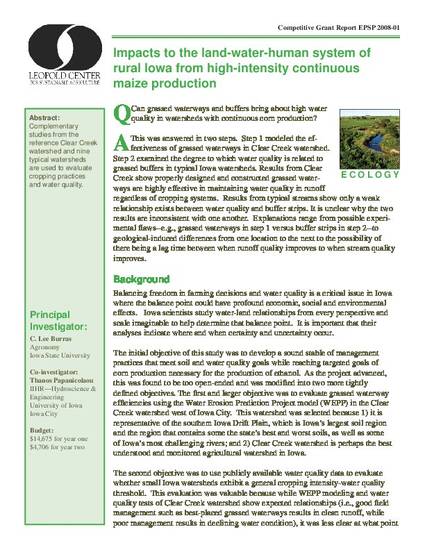
Unpublished Paper
Impacts to the land-water-human system of rural Iowa from high intensity continuous maize production
Leopold Center Completed Grant Reports
Project ID
EPSP2008-01
Abstract
Complementary studies from the reference Clear Creek watershed and nine typical watersheds are used to evaluate cropping practices and water quality.
Key Question
Can grassed waterways and buffers bring about high water quality in watersheds with continuous corn production?
Findings
This was answered in two steps. Step 1 modeled the effectiveness of grassed waterways in the Clear Creek watershed. Step 2 examined the degree to which water quality is related to grassed buffers in typical Iowa watersheds. Results from Clear Creek show properly designed and constructed grassed waterways are highly effective in maintaining water quality in runoff regardless of cropping systems. Results from typical streams show only a weak relationship exists between water quality and buffer strips. It is unclear why th two results are inconsistent with one another. Explanations range from possible experimental flaws--e.g., grassed waterways in step 1 verses buffer strips in step 2--to geological-induced differences from one location to the next to the possibility of there being a lag time between when runoff quality improves to when stream quality improves.
Principal Investigator(s)
C. Lee Burras
Co-Investigator(s)
Thanos Papanicolaou
Year of Grant Completion
2013
Disciplines
Citation Information
C. Lee Burras and Thanos N. Papanicolaou. "Impacts to the land-water-human system of rural Iowa from high intensity continuous maize production" (2013) Available at: http://works.bepress.com/c_burras/25/
